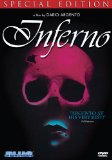| Reviews & Columns |
|
Reviews DVD TV on DVD Blu-ray 4K UHD International DVDs In Theaters Reviews by Studio Video Games Features Collector Series DVDs Easter Egg Database Interviews DVD Talk Radio Feature Articles Columns Anime Talk DVD Savant Horror DVDs The M.O.D. Squad Art House HD Talk Silent DVD
|
DVD Talk Forum |
|
|
| Resources |
|
DVD Price Search Customer Service #'s RCE Info Links |
|
Columns
|
|
|
Inferno

Dario Argento is a filmmaker whose work is easy to appreciate but difficult to love. He is easy to appreciate because his movies are the product of a specific vision and a unique, influential aesthetic. Argento's neon-lit sets and moody, Lovecraft-infused plots have atmosphere to spare. Yet he is difficult to love because his brand of horror, although suspenseful and engaging, is devoid of emotional content. His characters are often types - innocent virginal women and naïve, confused men - cast merely as the vulnerable targets of evil predators. There is little psychology or personality driving Argento's films - other than the director's own.
Inferno starts out strongly, with a voice intoning the mythological premise of an ancient book known as "The Three Mothers." We learn that three evil sisters secretly rule the world from lairs constructed specifically to harness their special powers. In New York, Rose (Irene Miracle) discovers that she may be living in one of these lairs - an old Gothic apartment building. She sends a letter to alert her brother Mark (Leigh McCloskey), a music student living in Rome. The letter finds its way into the hands of Mark's classmate Sara (Eleonora Giorgi), which in turn brings her to a tragic fate. Mark finds his way back to New York, but is too late to help his sister, who has already been found by the evil forces she has accidentally unleashed.
As an exercise in style, Inferno has a hermetic perfection about it. The visual method is characterized by large swathes of color (washes of light, spans of empty wall space, unusually large doors and windows) and graceful camera movements that always maintain compositional integrity. Argento creates his own visual grammar.
But Argento is somewhat undone by the characters he creates - one-dimensional types who don't have inner lives to speak of, nor are we ever certain that they have much comprehension of what is happening to and around them. This makes it difficult to empathize with them. If characters on-screen have some grasp of the plot (even when we don't), this makes it easy to forgive plot holes. We follow stories based on characters' experiences. It's never very clear that Rose or Mark understand that evil has been let loose in their world - and that might be acceptable if we knew that they know or don't know. Inferno leaves its characters in the lurch, however, without establishing clarity as to the protagonists' relationship to the horror they face. And this causes the film to lose momentum in its second half.
It's a shame that Inferno isn't strong enough to deliver on its many interesting ideas. Ultimately, a film's ideas need to be enshrined somewhere concrete within the film - and most often that place is within its characters. But Argento relies too heavily on visual technique, which, while impressive and often arresting, can't undo the awkwardness of characters who have been abandoned at the film's center.
The DVD
Image and Sound
Blue Underground presents Inferno in a very strong enhanced transfer that does great justice to the movie's bold color palette and striking imagery. Made in 1980, Inferno's image shows no sign of age. The transfer is rich in color, with dense black levels and appropriate sharpness. The soundtrack is available in a variety of mixes, including English 6.1 DTS, 5.1 Dolby Surround EX, and 2.0 Dolby Surround. I listened to the stereo track, since I figured that would be the closest to the film's original mix. The sonic experience was robust, atmospheric, and clean. Like the image, Inferno's soundtrack shows no sign of its age, apart from the somewhat dated (but perfectly suitable) score by Mark Emerson.
Bonus Content
Brief interviews with stars McCloskey and Miracle, and with Argento and assistant director Lamberto Bava, running an aggregate of about fifteen minutes, are all we get. The interviews are recent, and each participant offers interesting and fond recollections of the production. A commentary from Argento would have been nice, but judging from his manner in the interview, perhaps he eschews such things.
Final Thoughts
Inferno is worth seeing, particularly on a dark night with some friends and a bottle of tequila. It's carefully-mounted and meticulous in its look. But the movie fails to create characters who are capable of expressing much more than fear, and that keeps us out of their heads. Rent it.
|
| Popular Reviews |
| Sponsored Links |
|
|
| Sponsored Links |
|
|
| Release List | Reviews | Shop | Newsletter | Forum | DVD Giveaways | Blu-Ray | Advertise |
|
Copyright 2024 DVDTalk.com All Rights Reserved. Legal Info, Privacy Policy, Terms of Use,
Manage Preferences,
Your Privacy Choices | |||||||















